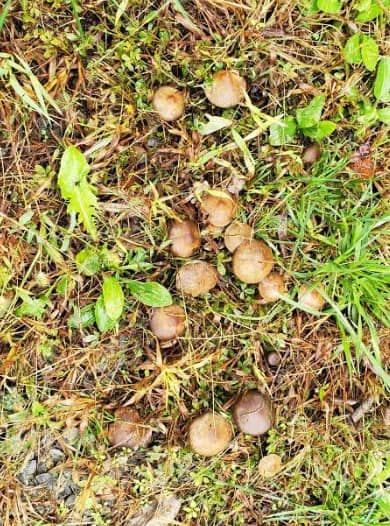I just read a story this morning of another dog dying of mushroom poisoning because they had no idea mushrooms growing in their yard are toxic. Please get up every morning and check your yards. I check morning and night because last year we had mushrooms here in Southwest Virginia on an off for about 8 months. Even in the Fall when it becomes cooler and we get some rain the mushrooms can pop overnight.
A few summers ago my little 6 pound Chihuahua Pepe was way to interested in mushrooms so I kept a close eye on him when he was out in the back yard. I am glad it is a practice that I have been diligent at because I ended up removing two dried up mushrooms from his mouth. It started out early one morning when Pepe was exploring the back yard to do his business. I turned around and noticed Pepe had something in his mouth and I immediately noticed a huge soggy mushroom hanging out the side of his mouth. At the time Pepe was standing in a really dry part of the yard so the nearest thing I could figure out is a squirrel dropped the mushroom on his way up our tree. I got Pepe to immediately to ‘drop it’! I had a sick feeling in my stomach that he had already eaten some of the mushroom so I went into major panic mode. I gave him 1/2 a tea spoon of 3% hydrogen peroxide and made him run around the back yard for about 10 minutes. After a few minutes, he threw up twice and what I discovered was his belly was full of mushrooms! I got lucky this time because I saw him with the mushrooms in his mouth. I was also was very fortunate to be able to get one of my Animal Vet friends on the phone so she could tell me what to do to get Pepe to throw up the mushrooms. These days if you are like me and have hearing and deaf dogs getting into things laying around on the ground, you have to be hyper vigilant and watch them every single second. I never ever leave any of my dogs unsupervised in the back yard which is fenced in.
I am happy to report to all of you that I did not lose my senior rescue dog that day so please check your yards twice a day before you let your dogs out.
Stay safe! ~ Christina Lee – Deaf Dogs Rock
Springtime Mushrooms are EVERYWHERE!
Every Spring when the days start getting warmer and the humidity goes up, (and when it rains a lot) it’s time to think about mushrooms. Yes, mushrooms! Mushrooms are toxic to you pets. I have two fenced yards and four pastures to search daily so none of my animals come across any mushrooms. Mushrooms can kill them! Today I am asking all of you to please go out every morning to check your yards for any sign of mushrooms so you can keep your dogs safe. Click here to see what poison mushrooms look like.
Even this year in the early fall with the cool temps I did not think the mushrooms would bloom but sure enough this week (Oct 15) there seem to be mushrooms everywhere.
Photos above: It is only 50 degrees out and raining and these mushrooms bloomed over night (October)!
As you can see from my photo below, I have a lot of poison mushrooms in my yard. I have five dogs so I get up early and check the yard before I let any of them do their business. These mushrooms smell yummy to a dog so it is crucial you go out and look for them every morning for the next 3 months or so before you let your dogs out in the morning and then in the Fall we will have to continue to check especially if it rains.
Stay safe! ~ Christina Lee – Deaf Dogs Rock
Here is a article I found on PetMd.com so you know what to look for if your dog starts getting sick.
Mushroom Poisnoning in Dogs
Mushroom poisoning occurs as a result of ingesting toxic mushrooms, which is a common hazard for dogs because of the amount of time they spend outdoors or in wooded areas, particularly in the summer and fall. Toxic mushrooms are classified into four categories (A, B, C, D), based on the clinical signs and their time of onset, and into seven groups (1-7) on the basis of the toxin they contain. However, because it is sometimes difficult to identify what type of mushroom your dog has consumed, you should always bring the suspected mushroom with you when you take your dog to the veterinarian.
Symptoms and Types
Symptoms vary greatly depending on the type of mushroom ingested. Category A mushrooms, for example, are the most toxic and cause the destruction of cells, especially liver and kidney cells. Category B and C mushrooms, meanwhile, affect nervous system, and category D mushrooms cause gastrointestinal irritation. The following are some of the more common symptoms associated with mushroom poisoning:
Vomiting
Diarrhea
Abdominal pain
Weakness
Lethargy
Yellowing of the skin (jaundice)
Uncoordinated movements
Excessive drooling (ptyalism)
Seizures
Coma
Causes
Ingestion of toxic mushroom(s).
Diagnosis
You will need to give a thorough history of your dog’s health to your veterinarian, including the onset and nature of the symptoms, and possible incidents that might have precipitated the complications. He or she will then perform a complete physical examination as well as a complete blood count, biochemistry profile, and urinalysis — the results of which may reveal may reveal abnormally low blood glucose levels (hypoglycemia) and abnormally high levels of liver enzymes due to liver damage. Your veterinarian will also typically take a sample from the stomach to identify the type of mushroom.
Click here to read the full article on PetMD.com














